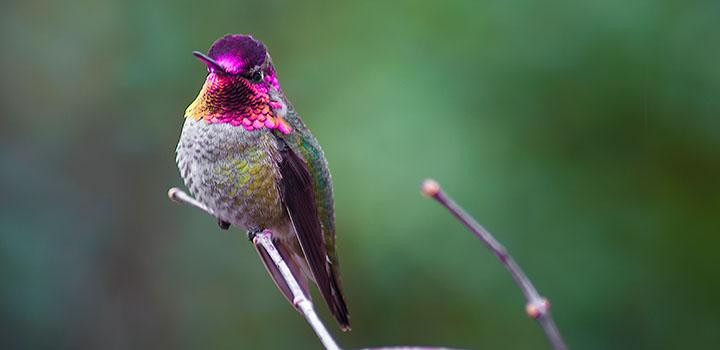
Anna's Hummingbird
Posted by Grange Co-op on 30th Nov 2015
Male: Iridescent green upper body, grayish chest and central belly, long black bill, partial white eye ring. In direct sunlight, the dark head, (crown and throat), shines a deep rosy red.
Female and Juvenile: Similar to male, with green crown and only a few rosy flecks on the throat instead of a complete rose red.
 NESTING:
NESTING:
Early breeder, can lay eggs in December to May depending on location. Female builds a tiny cup nest of downy plant fibers, decorated with lichens, held together with spider’s silk. Nest is placed in variety of locations on a tree or shrub branch, often near houses. 1-3 white eggs without markings, 2-3 broods per year. After mating the female raises young alone. In the morning, she feeds them nectar, for quick energy to warm them while she forages. In the afternoon, she feeds them insects.
FEEDING:
Hovers, sometimes perches, to sip flower nectar and sugar water. Gleans insects from flowers and shrubbery. Readily visits hummingbird feeders. Males are territorial, but tolerates other hummingbirds if food is plentiful.
RECOMMENDED FEED:
Make a solution of one part white granulated sugar to four parts water, boil and cool. Change sugar solution and wash feeder every 3-4 days to prevent molds and fungus that are hazardous to the bird’s health.
RECOMMENDED FEEDERS:
Small, flat bottom feeders that won’t drip. Aspects Hummzingers, Birds Choice Hummerdome, Best-1 bottle feeders. Shop Hummingbird & Oriole Feeders.
HABITAT:
Oak woodlands; chaparral; riparian areas; coastal scrubland; farmlands; parks; urban gardens especially with red tubular flowers or hummingbird feeders. Anna’s are a locally common summer breeding resident and lower elevation winter resident in western interior valleys and along the coast; locally uncommon summer resident in the Klamath Basin and other parts of southern Oregon.
OTHER INTERESTING FACTS:
Male defends ¼ acre territory and does spectacular dive displays, rising to 120 ft., diving down at speeds reaching 65 mph, veering up at bottom of dive while giving a loud “speeek” sound. Their complex song is a series of squeaky phrases; call is “chip”.
COMPARE TO:
Rufous Hummingbird is smaller and has a characteristic burnt-orange color.
Would you like to attract birds to your yard? We’ve got a great selection of products to help you and your feathered friends get together. Shop our Wild Bird department now.
